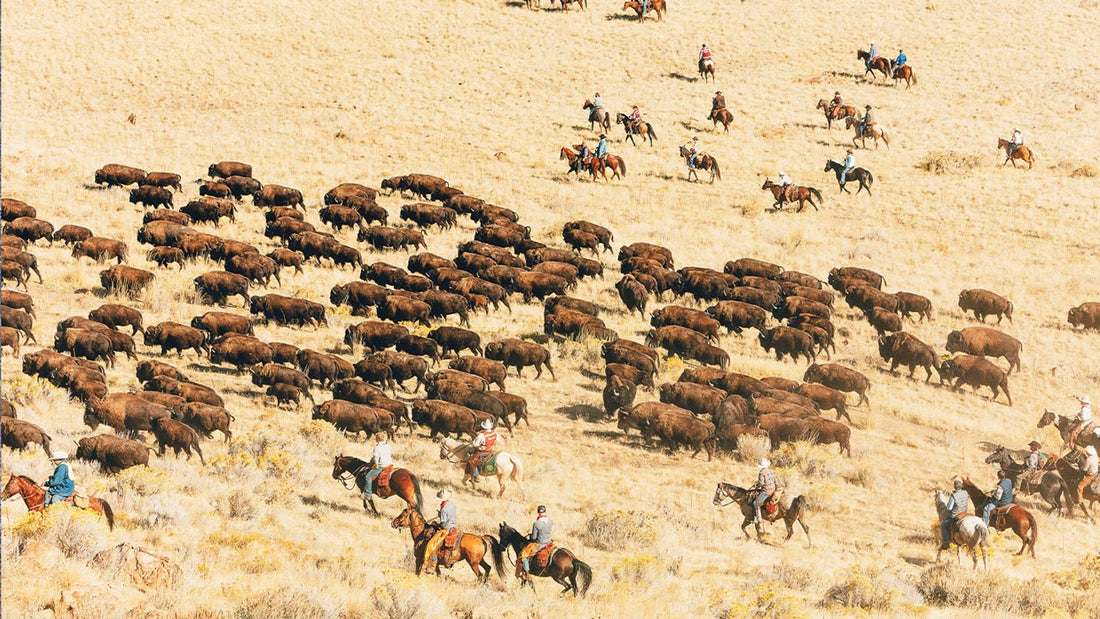The Push to 1 Million Bison
Force of Nature
Before the mid-1800s, somewhere between 30 and 60 million bison roamed North America. For millennia they served as an important keystone species in which ecosystems were nourished through their presence. Beginning around the year 1830, 50 million bison were killed by American settlers and Native tribes. Some were hunted for meat and fur, but many were killed for sport. In just one year, in 1870, 2 million bison were slaughtered on the southern plains. Between 1872 and 1874, 5000 bison were killed every single day. By 1884, the American bison population had been reduced to as few as 325. Twenty-four of these 325 were in Yellowstone National Park. Remember this for later; these 24 are an important part of the story of bison post-19th century.

Bison . . . Not Buffalo
Bison are powerful, majestic creatures. A male bison grows to weigh as much as 2200 pounds and measure six feet tall and 11 feet long. A bison’s tail measures between 20 and 23 inches. And yet, despite their extraordinary size, bison can run an impressive 40 miles per hour. A single blow from a bison’s horns (which can grow as long as two feet) is likely to be deadly, although bison, staunch herbivores, are more likely to use their horns as snowplows, swinging their heads from side to side to make paths in the winter, than weapons (this doesn’t mean they aren’t occasionally used for self-defense, though—they’re even used to fight other male bison during mating competitions). In the wild, bison typically live for 12 to 20 years; in captivity they can live up to 30.
Although bison are often referred to as “American buffalo,” or even just “buffalo,” they are not buffalo. In fact, bison are more closely related to cows, and even goats, than buffalo. Bison are found only in North America (Bison bison) and Europe (Bison bonasus), while buffalo reside in Africa (Syncerus caffer) and Asia (Bovinae bubalis). Bison are usually larger than buffalo (although Asian buffalo can have far more massive horns, at nearly six feet long), and they have shaggier, longer fur.

Bringing Back the Bison
In 2017, at the International Bison Conference in Big Sky, Montana, the National Bison association announced Bison 1 Million, a campaign with the goal of growing the population of bison in North America to 1 million—ideally within a decade.
Bison 1 Million is not the first initiative to restore the bison population. In 1902, 21 bison were brought to Yellowstone and bred with the 24 or so that were already there. In 1905, Theodore Roosevelt, an avid hunter and one of the country’s first conservationists, noted his concern for the devastated U.S. bison population in his annual message to congress. In 1907, the American Bison Association, of which Roosevelt had been named honorary president, began their own campaign to restore the bison population. In conjunction with the Bronx Zoo, they began shipping bison out west, to the American plains. Today, there are about 5,000 bison in the Yellowstone herd, and Yellowstone is the only place in the continental United States where bison have lived free-ranging continuously since prehistoric times. They’re also one of the only pure-bred herds left on the continent (most bison have been interbred with cattle at some point).
In the ensuing years, we’ve made a lot of progress. The International Union for Conservation of Nature currently lists bison as “near threatened.” In 2011, the bison was named the national mammal of the United States. When the Bison 1 Million initiative was announced in 2017, there were 385,000 bison in North America. Today, just a couple years later, there are about 500,000 spread amongst various ranches, national parks, and 53 tribal herds on native lands.
Some calculations estimate that bison can expand at a rate of 20 percent per year under optimal conditions. But conditions are not optimal. Both space constraints and disease threaten bison herds across the continent and make restoration difficult. Brucellosis is a particular concern—bison and elk inherited this disease from cattle in the early 1900s (interestingly, brucellosis has since been almost entirely eliminated from the cattle population). All this said, if bison herds could be supported to expand at the rate of just a little over 10 percent per year, the North American population could reach 1 million by as soon as 2025.

Join Us in the Push to 1 Million Bison
So how can you help restore the bison population?
If you’re a consumer, eat bison! More importantly, eat grass fed bison. And encourage others to do the same. Americans eat 50-52 pounds of beef per year on average, but they eat only .08 pounds of bison meat. Bison is a leaner, more nutritious meat than beef, with more iron, vitamin B12, and protein per serving. This might seem counter intuitive, however is simple supply and demand economics. As the demand for bison meat goes up, so too will the supply.
If you’re a rancher, farmer, or conservationist, your involvement in the push to 1 million bison is crucial. As Force Of Nature continues to accelerate the creation of a market place for grass fed bison meat, we are actively looking for new suppliers. If you are interested in raising bison for us, please contact us at info@forceofnaturemeats.com
If we work together, these majestic beasts can soon rule the plains of North America once again.